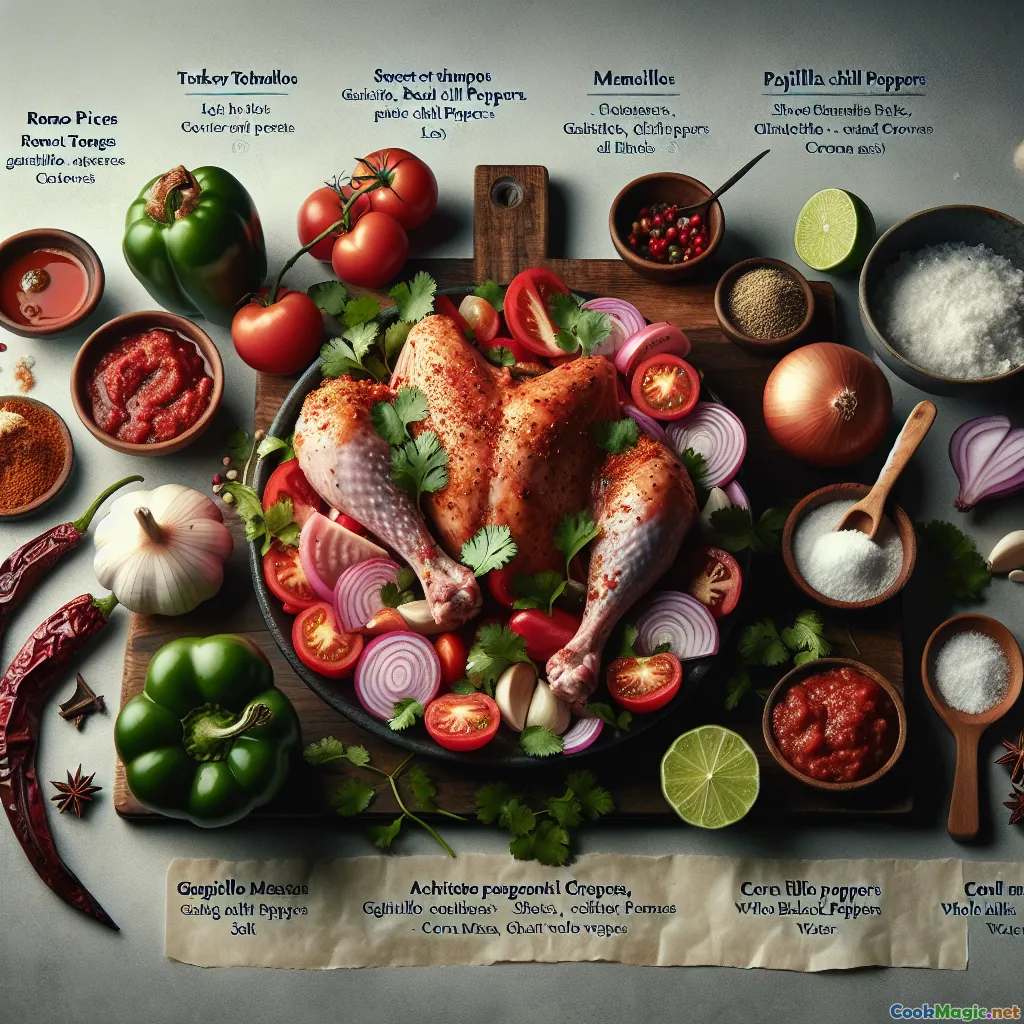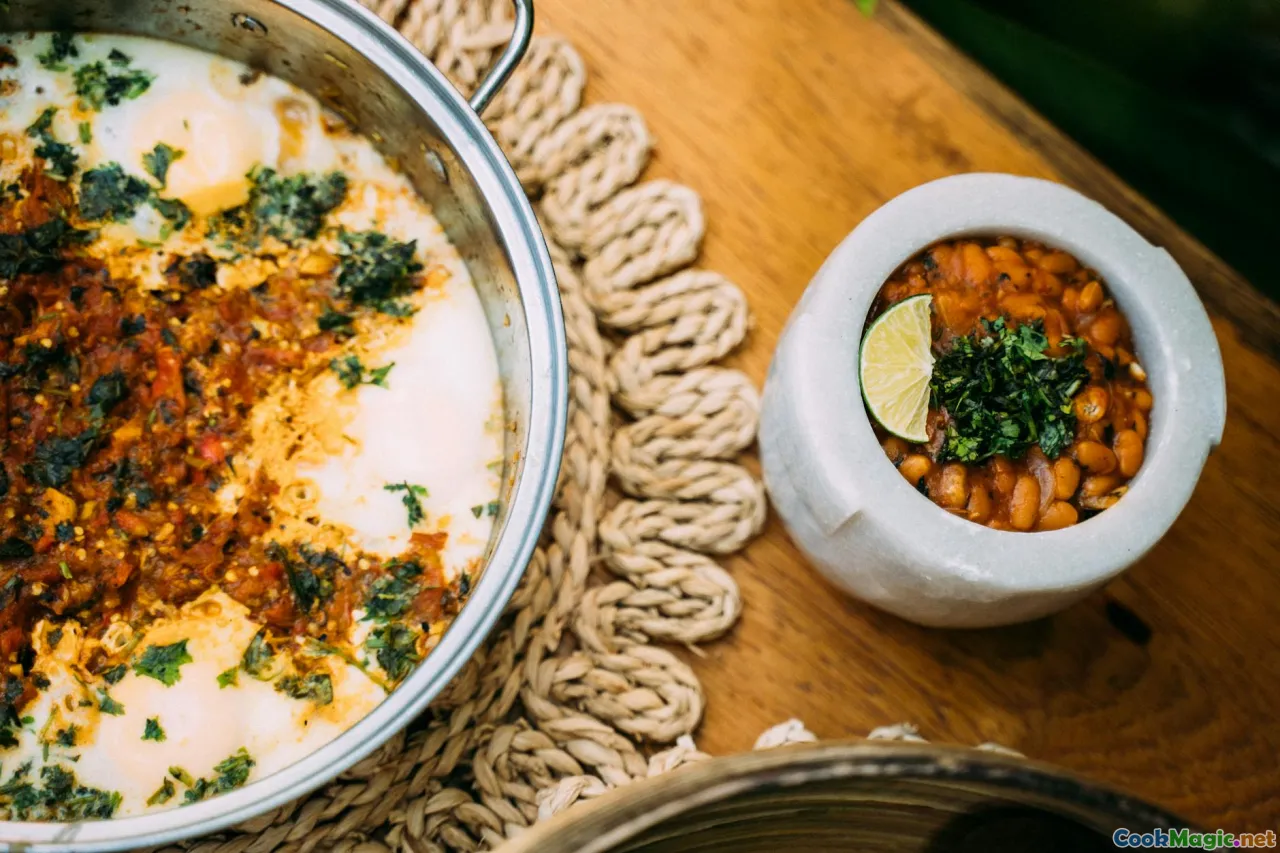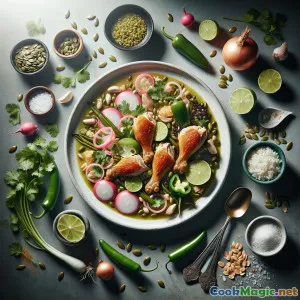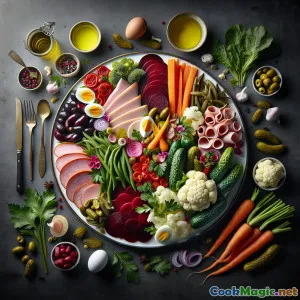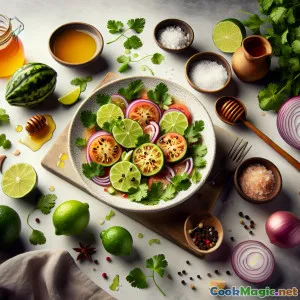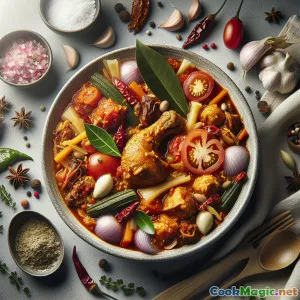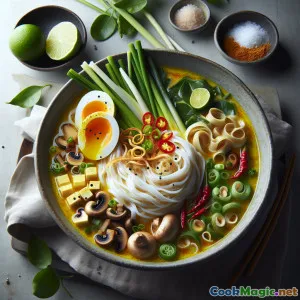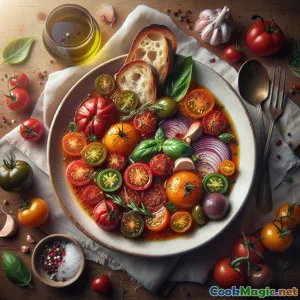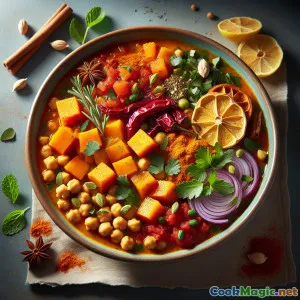
Sopa Kak'ik Ahumada: Estofado Picante de Pavo de Guatemala
(Smoky Kak'ik Soup: Guatemala's Spicy Turkey Stew)
(0 Reseñas)0
1,046
julio 15, 2025
Informar de un problema
Ingredientes
-
1.2 kg Piezas de pavo (piernas, muslos, alas)
(Piezas con piel o un pequeño pavo entero cortado, limpio)
-
4 medium Tomates Roma
(Fresco, maduro)
-
3 medium Tomatillos
(Pelado y enjuagado)
-
1 large Pimiento rojo dulce
(Picado grueso)
-
2 tbsp Pasta de achiote
(Para un color intenso y sabor terroso)
-
2 whole Chiles Guajillo
( Sin semillas y sin tallos)
-
1 whole Chiles Pasilla
( Sin semillas y sin tallos)
-
6 whole Dientes de ajo
(Pelado)
-
1 large Cebolla blanca
(Picado)
-
1 bunch Cilantro
(Reserva algunas hojas para decorar)
-
1 small handful Menta
(Preferiblemente, hierba buena local)
-
5 pieces Bayas enteras de pimienta de Jamaica
(Opcional, añade notas cálidas)
-
4 tbsp Masa de maíz
(Para espesar o como substituto de harina de maíz)
-
6 pieces Gajos de lima
(Para servir)
-
2 tsp Sal
(Al gusto)
-
1 tsp Pimienta negra en grano
(Recién abierto)
-
2.5 liters Agua
(Caldo casero de pavo o pollo, si está disponible)
(Piezas con piel o un pequeño pavo entero cortado, limpio)
(Fresco, maduro)
(Pelado y enjuagado)
(Picado grueso)
(Para un color intenso y sabor terroso)
( Sin semillas y sin tallos)
( Sin semillas y sin tallos)
(Pelado)
(Picado)
(Reserva algunas hojas para decorar)
(Preferiblemente, hierba buena local)
(Opcional, añade notas cálidas)
(Para espesar o como substituto de harina de maíz)
(Para servir)
(Al gusto)
(Recién abierto)
(Caldo casero de pavo o pollo, si está disponible)
Nutrición
- Porciones: 6
- Tamaño de porción: 1 tazón grande (~350ml)
- Calories: 450 kcal
- Carbohydrates: 0 g
- Protein: 57 g
- Fat: 15 g
- Fiber: 6 g
- Sugar: 7 g
- Sodium: 780 mg
- Cholesterol: 125 mg
- Calcium: 78 mg
- Iron: 3.2 mg
Instrucciones
-
1 - Preparar chiles y verduras:
Tostar ligeramente los chiles guajillo y pasilla en una sartén caliente y seca (comal) hasta que tengan aroma, pero sin quemarlos. Retirar del fuego y remojar en agua tibia durante 10 minutos hasta que se ablanden.
-
2 - Aromáticos para Sofreír:
En la misma sartén caliente, asa los tomates, tomatillos, ajo, cebolla y pimiento hasta que estén bien quemados y un poco carbonizados, girándolos según sea necesario para un asado uniforme. Retira del fuego y reserva.
-
3 - Mezcla la Base:
En una licuadora, combina chiles suavizados, verduras asadas, pasta de achiote, pimienta negra, pimienta de Jamaica (si se usa) y 1 taza de agua. Licúa hasta obtener una pasta muy suave y espesa.
-
4 - Dorar el pavo:
En una olla grande y pesada, calienta un poco de aceite. Dora los trozos de pavo en todos lados para un sabor profundo. Retira el exceso de grasa si es necesario.
-
5 - Cocer pavo a fuego lento:
Agrega la pasta de chile triturada a la olla de pavo. Vierte el agua restante (o caldo). Añade sal. Lleva a ebullición, reduce el fuego y cocina a fuego lento tapado durante 60 minutos hasta que el pavo esté tierno y el caldo tenga un color intenso.
-
6 - Agregar hierbas y masa:
Mezcla la masa de maíz con un poco de caldo para hacer una pasta suave. Incorpora cilantro, menta y la mezcla de masa en la sopa. Cocina a fuego lento durante otros 10 minutos para espesar ligeramente e infusionar aromas.
-
7 - Adornar y Servir:
Prueba la sal y ajusta si es necesario. Sirve la sopa caliente en platos grandes, cada uno con un trozo generoso de pavo, mucho caldo, cilantro fresco y una rodaja de lima para exprimir.
Tostar ligeramente los chiles guajillo y pasilla en una sartén caliente y seca (comal) hasta que tengan aroma, pero sin quemarlos. Retirar del fuego y remojar en agua tibia durante 10 minutos hasta que se ablanden.
En la misma sartén caliente, asa los tomates, tomatillos, ajo, cebolla y pimiento hasta que estén bien quemados y un poco carbonizados, girándolos según sea necesario para un asado uniforme. Retira del fuego y reserva.
En una licuadora, combina chiles suavizados, verduras asadas, pasta de achiote, pimienta negra, pimienta de Jamaica (si se usa) y 1 taza de agua. Licúa hasta obtener una pasta muy suave y espesa.
En una olla grande y pesada, calienta un poco de aceite. Dora los trozos de pavo en todos lados para un sabor profundo. Retira el exceso de grasa si es necesario.
Agrega la pasta de chile triturada a la olla de pavo. Vierte el agua restante (o caldo). Añade sal. Lleva a ebullición, reduce el fuego y cocina a fuego lento tapado durante 60 minutos hasta que el pavo esté tierno y el caldo tenga un color intenso.
Mezcla la masa de maíz con un poco de caldo para hacer una pasta suave. Incorpora cilantro, menta y la mezcla de masa en la sopa. Cocina a fuego lento durante otros 10 minutos para espesar ligeramente e infusionar aromas.
Prueba la sal y ajusta si es necesario. Sirve la sopa caliente en platos grandes, cada uno con un trozo generoso de pavo, mucho caldo, cilantro fresco y una rodaja de lima para exprimir.
Más información sobre: Sopa Kak'ik Ahumada: Estofado Picante de Pavo de Guatemala
Kak'ik de Quetzaltenango: A Fiery, Aromatic Classic from the Guatemalan Highlands
Kak'ik is one of the jewels of Guatemalan cuisine, perched proudly on tables during family celebrations and festive occasions in the country’s western highlands, especially around Quetzaltenango (also called Xela). At first glance, it appears to be a simple “turkey stew,” but unpacking a single bowl reveals the rich history, vibrant ingredients, and stubborn Mayan traditions that have survived centuries of change.
Historical & Cultural Significance
Kak'ik (pronounced kahk-eek) traces its roots to the ancient Mayan people, who settled in Guatemala well before the Spanish conquest. The name itself derives from the Q’eqchi’ Mayan language: 'kak' meaning “red” and 'ik' meaning “hot, or spicy.” Although now spread across many regions, it remains particularly meaningful in Quetzaltenango, where indigenous Cakchiquel and Mam communities craft their brothy staple much as their ancestors once did—wood-fire, clay pots, and all.
Traditionally, Kak’ik uses wild turkey or 'chompipe,' an animal with deep ritual and culinary value. The bright scarlet color, imparted by heaps of luscious ripe tomatoes, annatto (achiote), and chilis, recalls strength and sacrifice.
What Makes This Version Unique?
- Layered Smokiness: Step one is the subtle toasting and charring of chilis and vegetables, a classic Mayan technique lending unparalleled depth.
- Aromatic Thickeners: By swirling masa (corn dough) in at the end, the broth gains a pleasing, silky body, echoing Guatemalan tortillas. This version uses fresh cilantro and native mint—bold and fragrant.
- Rustic Presentation: Each bowl boasts a meaty turkey chunk surrounded by a sunset-red broth, sometimes eaten with 'tamales de masa' or simple white rice on the side.
Substitutes, Serving, and Tips
- Use chicken if turkey is unavailable, but the wilder gaminess of turkey is more traditional and flavorful.
- Toltec and Mayan recipes use native 'hierba santa' instead of mint—seek it out for a truly authentic fragrance.
- Adjust chili quantity for a milder or feistier soup.
- Leftovers can be refrigerated up to 3 days; flavors deepen substantially overnight.
Perfect Pairings
Guatemalan corn tortillas or a classic rice side (‘arroz blanco’) turn Kak’ik into a hearty main. For festivals, locals pour it into large bowls and gather family together—every bite is connective, memorable.
Personal Thoughts
Cooking Kak'ik is like traveling in both time and place. The scents—spicy, smoky, and green—waft through the kitchen, teaching patience and respect for Maya culinary ritual. Many Guatemalan cooks say, “A soup isn’t ready until it’s shared.”
So treat Kak'ik de Quetzaltenango as more than a weekend culinary project; see it as a stew layered with history, community, and flavor. Whether you're seeking warmth, a taste of Central America, or the magic of Mayan food technology, this recipe is your gateway to a singular, spicy tradition.
